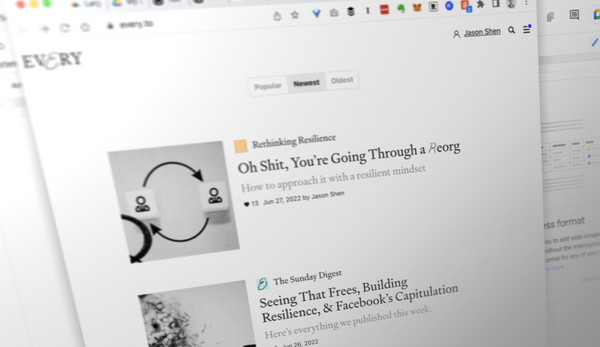I’ve been thinking a lot about reorgs, and how you can stay resilient through the abrupt changes they can bring. That’s the topic of my latest piece in Every: Oh Shit, You're Going Through a Reorg.
According to Layoffs.fyi, 850 tech companies have laid off a collective 138k employees since March of 2020. In the month of June alone we’ve seen Masterclass, Coinbase, Compass, Stitch Fix, Bird, and Superhuman all do layoffs representing 15%+ of their total employee base.
Layoffs often go hand in hand with reorgs.
Sometimes the reorgs come before, as a way to fix performance, or in anticipation of the layoff. Sometimes they come after, once the damage has been done and the full loss has been realized.
I experienced both versions at Etsy.
When I joined Etsy in 2015, it had recently gone public. After a brief surge, the company’s stock struggled through all of 2016. I went through my first experience of a surprise reorg then. My team was reassigned from leading overall development of the seller-facing mobile app to implementing the mobile version of a specific new feature built on web.
I was frustrated by this sudden turn of events, just as I felt I was getting a chance to lead an area, it was taken away from me. But I was told the new project was necessary for the company’s a big bet. A chance to prove to the board and investors that Etsy had new opportunities for growth.
That big bet was Etsy Studio.
We had come up with an initiative to launch a standalone craft marketplace that was distinct from the main Etsy site and brand and were investing ever more resources to make it happen. After several delays, we finally shipped it to much fanfare in Feb 2017.
But after a brief spike, it got lackluster usage. Etsy Studio’s deflated reception may have been the last straw for then CEO Chad Dickerson.
In a surprise all-hands in May, Dickerson announced he had been fired by the board and was also implementing an 8% layoff (about 80 people), with a new CEO stepping in effective immediately.
The new CEO Josh Silverman went about redirecting resources across the company, focusing on driving buyer-related initiatives.
On the seller-side, things seemed ominously quiet. My manager, a long-time employee, left the company, and my new manager seemed to not have much to say to me.
Then in June 2017 Silverman talked a great deal about focusing on the vital few initiatives, and would shut down Etsy Studio by its 1st birthday. He announced a second set of layoffs, another 15% of the company, this time including me.
This was a turbulent time for our industry. Chances are good that your company will undergo a major reorg or layoff this year, if you haven’t already.
Whether you’re a manager or an individual contributor, this 4,300 word piece goes into more concrete detail about how to ensure you make it through a reorg with minimal suffering and maximum opportunity.
Here's a brief excerpt:
Resilience Skill #2: Restoring What’s Been Lost
Engineering teams often use the terms P0, P1, P2, P3 to indicate task priorities for a given project. At Meta, the phrase “you are your own P0,” has become a mantra and a shared reminder that caring for your well-being must always be your highest priority ahead of any work task. You can’t stay in firefighting mode forever and reorgs take an unavoidable human toll. Whether you’re a manager or an individual contributor, there are ways you can create space for yourself and your colleagues to restore a sense of safety and connection. Here are some ways you can regain your balance.
Check In
It’s critical during a reorg to stay in touch with ourselves and our teams. In the flurry of activity, we often lose track of how much things may be changing and how the changes have affected us. You might be experiencing a lack of recognition for your previous achievements, your team might feel that their hard work has been wasted. You may feel a loss of confidence as you take on an unfamiliar role with new faces speaking in strange acronyms and jargon you don’t understand.
Labeling our emotions is an effective way to regulate these difficult feelings. In his book on the teenage brain, neuropsychiatrist Daniel Siegel uses the phrase “name it to tame it” to offer parents a way to support and deescalate the powerful and often distressing emotions of their adolescent children.
During my time at the Techstars Alexa program, then managing partner Aviel Ginsburg held a weekly CEO round table where he introduced many of us to the “Traffic Light” check-in. We would begin each session with a quick status on each of our emotional states at the moment, and where it was “trending” or forecasted to be in the near future.
Green meant things were going well: we had lots of energy and optimism. Yellow meant we were experiencing some issues, problems, or negative emotions, but it was mostly under control. Red meant you were in crisis mode, feeling overwhelmed and experiencing significant distress.
While incredibly simple, the Traffic Light check-in at the start of a meeting or 1:1 gives people who might not always be in touch with their emotions (all of us) or who aren’t ready to get extremely vulnerable with a group to at least share their general state. Your color report can then serve as a jump-off point to asking for help or providing support, as we’ll discuss in the next two strategies.
Keep reading: Oh Shit, You’re Going Through a Reorg

